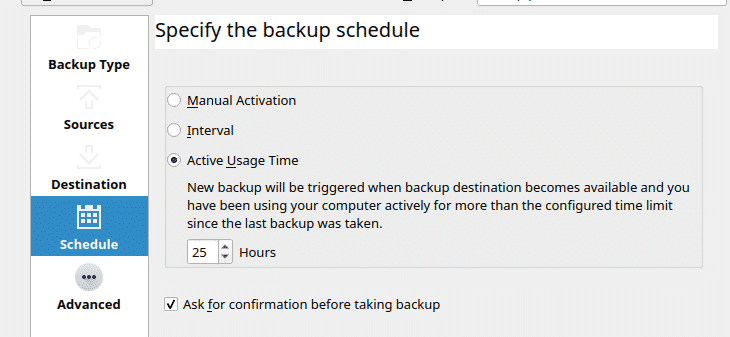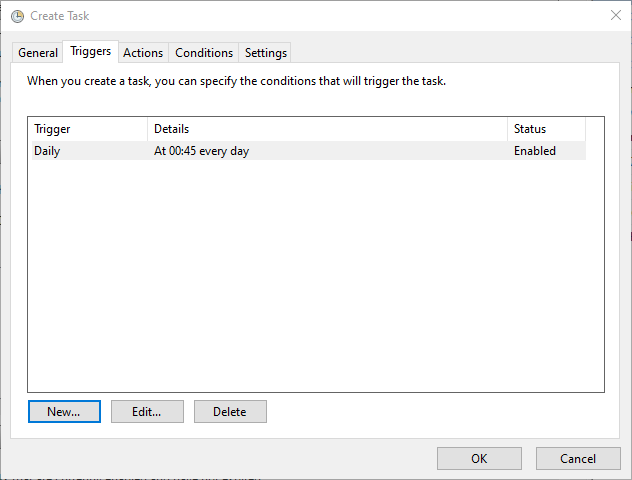

Click on the Triggers tab at the top of the screen.Now click Run whether user is logged on or not and Run with highest privileges.Select the user that has all the admin rights.

Choose the Create Task… option that’s under Actions pane on the right-hand side of the screen.In the Command Prompt, type Taskschd.msc.Now go to Start > All Programs > Accessories > Command Prompt to open Command Prompt.Note: You must specify the SET parameters and the mysqldump.exe location as per your configuration. First, open Notepad and save the following MySQL backup script.9 steps are all it takes! Ready to get going? Don’t worry, it’s going to be quite easy.
BACKUP SCHEDULER IN LINUX WINDOWS
If you want to use a MySQL backup script to backup your Windows server data, then you must follow the steps listed below. Let’s get started! Create MySQL Auto Backups in Windows Server Using MySQL Backup Script in 9 Easy Steps
BACKUP SCHEDULER IN LINUX DOWNLOAD
With this script, you won’t need to download any MySQL backup tool. If you’re a website administrator, this article will give you MySQL backup script for quick MySQL backup in Linux as well as in Windows. That’s why, backing up data regularly has become a routine for many. This fear rises with each upload and change made to the data structure. Just like we’re afraid of losing all our data from our devices, website administrators are afraid of losing all the data from their web servers. But there’s one thing in common between us and them, and that’s the constant fear of losing all your data and information. With weird clothes and geeky spectacles, website administrators look like different animals compared to us. The sytax is shown below.Here’s how you can enable automatic backups on your web server using MySQL backup script and tool You need to run a backup script once every year on a specific date in february month. Schedule a job at February 2nd, every year The first 5 fields have the following format: FieldĮxample cron jobs 1. This can be any type of command or shell script.

The first 5 fields define the time, the final field contains the command to run. The figure below shows the syntax of a cron job.Įach line in a file defines a job.

Instead, a program called crontab is used to manipulate them. The files in /var/spool/cron are not edited directly. These files always belong to the user root. The jobs of individual users are stored in the directory /var/spool/cron in files matching the usernames. The system cron table that has commands to run scripts located in the following directories: /etc/cron.hourly, /etc/cron.daily, /etc/cron.weekly, and /etc/cron.monthly.Ī directory that contains cron tables for jobs that need to run on a schedule other than hourly, daily, weekly, or monthly.ĭirectory that contains system scripts to run on an hourly basis.ĭirectory that contains system scripts to run on a daily basis.ĭirectory that contains system scripts to run on a weekly basis.ĭirectory that contains system scripts to run on a monthly basis. Specifies users who are not allowed to create a cron table. Specifies users who can create a cron table. User crontab files are stored in the /var/spool/crondirectory. System messages related to the cron process. Knowledge of these files and directories will help you troubleshoot any issues as well as understand cron in more detail. The table below summarizes the purpose of the various files and directories used by cron. It wakes up once every minute and checks /etc/crontab, /etc/cron.d, and the user cron table files and determines whether there are any jobs that need to be executed. The cron background process is mostly idle. # crontab -u john -l Cron configuration files Empty lines are allowed, and comments start their line with a hash symbol (#). The file being edited will have one job per line. unless the EDITOR environment variable has been set to something different). When editing jobs with the “ crontab -e“, an editor will be started (vi by default. If no file is specified, stdin will be used. Remove all jobs, and replace with the jobs read from. This command can be called in four different ways: Command Normal users can use the crontab command to manage their jobs. The cron utility uses a table (crontab) with a list of scripts or commands to be executed and the time when they are to be executed. It allows you to schedule tasks to be run in the background at regular intervals. The cron utility is the most widely supported. The GNU/Linux system supports several utilities for scheduling tasks.


 0 kommentar(er)
0 kommentar(er)
